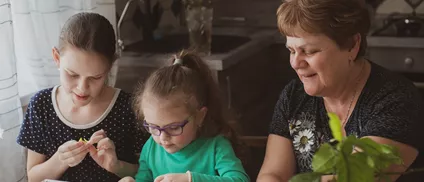
Secure Base Model Explained
Explore the benefits of the Secure Base model and how it helps children in care feel safe and secure.
The Secure Base Model is a framework designed to help foster parents provide therapeutic care for children in foster care.
It emphasises the importance of healthy relationships in helping children recover from trauma. By being mindful of your thoughts, feelings, and actions, you can create a safe and trusting environment that supports a child’s healing, self-esteem, and emotional growth.
In this article, you’ll learn:
What is the Secure Base Model?
Designed specifically for children in care, the Secure Base Model is a framework that supports foster parents in providing therapeutic foster care. Children learn how to relate to others and themselves through their relationships, so their thoughts, feelings and behaviours connect and are influenced by those of their caregivers.
When a child has experienced abuse or neglect from a caregiver, it can deeply impact their self-perception and trust in others. Trauma often arises in these primal relationships, making it challenging for children to feel safe and trust new ones. However, forming new, healthy relationships—such as with foster parents—is essential for their recovery.
The Secure Base Model, therefore, teaches you, as a foster parent, to be mindful of the messages you convey through your thoughts, feelings and actions in daily interactions with the children in your care. By doing so, you can nurture a sense of trust and safety and begin rebuilding their self-esteem, confidence and resilience.

The 5 Dimensions of the Secure Base Model
There are five dimensions to the Secure Base Model. Each element focuses on the specific interactions you can have with the children in your care to help them gain trust, manage their feelings, build self-esteem, feel effective, and develop a sense of belonging.
Availability – helping the child to trust
Availability is about being emotionally, mentally and physically there for the children in your care. Demonstrating that they can rely on you by being consistent and reliable so they learn they can trust you to meet their needs.
Children who have moved into care may have experienced parents being unavailable to meet their needs in some way. They may have developed survival strategies and struggle to trust adults to be there for them or care about their wants and needs.
How you can help a child to build trust
When you welcome a child who has experienced an inconsistent availability of care, they may avoid interactions, become clingy, or present mixed behaviour and feelings. The way they relate to you is based on their relational experiences.
You can begin building trust through small interactions that demonstrate to the child in your care that you care about them as an individual and understand what makes them unique.
For example, if the child in your care struggles with separation anxiety, you could draw hearts on both of your wrists, so they know that you are always with them and are thinking about them even when you aren’t together. If they are having a tough day, you could buy them their favourite treat or cook their favourite meal, so they know you have been thinking about their unique likes.
Routine is another way of forming trust because it creates a sense of stability. You could make it routine to spend quality time with the child in your care by watching their favourite TV show or participating in a joint activity. These consistent and reliable interactions that become routine demonstrate that you want to spend time with them and that they matter to you.
Building trust additionally involves maintaining a predictable and consistent approach when responding to behaviour and events. If, for example, you respond to a child in distress by talking calmly, you should continue to use this approach. When children know what to expect, they realise their caregiver is not a threat, which helps them relax, trust, and accept the care provided.
Sensitivity – helping the child to manage feelings
Sensitivity is about empathy and imagining what it might be like emotionally for the child in your care. It’s taking the time to tune into what they may be thinking and feeling and helping them learn to regulate their emotions by reflecting on and working through them together.
Children in care may not have experienced sensitivity; they may have had their emotions ignored or received a berating for displaying them. Children learn how to regulate and understand emotions through their caregivers. So, they may struggle to put their thoughts and feelings into words or to regain composure after expressing big feelings.
How you can help a child manage their feelings
As a foster parent, you can help the child in your care by considering what is happening in their inner world and thinking aloud about how they may be feeling. For example, if they express big emotions every morning before school, think about what may be triggering them and voice these ideas. Even if you get it slightly wrong and they correct you, this correction will lead to a better understanding.
It’s also crucial to offer empathy, even when their reactions seem irrational. Some children function at a younger developmental age, so their behaviours and emotional responses may resemble those of a considerably younger child. For example, an 11-year-old may react to being unable to find their favourite t-shirt in the same way a toddler would, having never been taught how to regulate their emotions effectively.
Through empathy and a shared understanding, you can help the child in your care name and navigate their feelings, teaching them healthy ways to manage their emotions.
If the child in your care finds it hard to share their emotions, play is an indirect way for them to gain confidence to share their feelings, as it can feel less intense than having a one-on-one conversation. At ISP, therapeutic play is part of our foster parent training programme. We teach you how to play in a way that allows children in your care to express themselves so you can both build a deeper understanding of how they think and feel.
The Secure Base Model emphasises the impact a caregiver’s thoughts, feelings, and behaviour have on that of a child, so we need to walk the talk and show them what it’s like to have emotions, how to share them and how to manage them safely.
Acceptance – building the child’s self-esteem
Acceptance is about demonstrating that you accept the child in your care for the unique qualities and attributes that make them who they are and celebrating their individuality to help rebuild their self-esteem.
Many children in care have low self-esteem. They may believe they are the reason they are in care and base their self-worth on how they’ve been treated. When a child experiences prolonged abuse or neglect, this repetitive behaviour may lead them to believe they are unworthy of love.
How you can help build a child’s self-esteem
As a foster parent, you can help build a child’s self-esteem by repeatedly demonstrating that they are worthy. Getting to know the child in your care is the first step to helping achieve self-worth. What are their beliefs and values? What is their culture and identity? Do they identify with any characters from a book? Once you’ve learnt more about the child in your care, you can encourage them to embrace their individuality and help celebrate it by taking an active role.
For example, if the child in your care loves football, you could encourage them to join a team and ensure you are watching and cheering them on each week, demonstrating that you believe in them. If they have a particular faith, you could attend religious meetings together, showing that you understand the importance of their faith. You can also build self-esteem during everyday interactions by praising the child in your care for small things, such as doing a particular chore and by putting hand-written notes in their lunch box.
Modelling self-acceptance can also go a long way because it demonstrates that no one is perfect; everyone has their quirks, but that doesn’t mean they aren’t worthy of love and acceptance.
Co-operation – helping the child to feel effective
Co-operation is about feeling effective and having a purpose by helping children in care feel competent in making decisions. It’s about giving children choices and working together so they know their input is valued.
Children in care may lack a sense of control over their lives because things have happened to them that they were powerless to stop. They have also had no choice in moving into care and may feel frustrated by a lack of autonomy.
How you can help a child to feel effective
As a foster parent, you can help the child in your care feel effective by giving them more responsibility. For example, if the child is old enough to make their own packed lunch, let them. By doing so, you are giving them some autonomy over what they will eat for lunch and are demonstrating that you trust them. You could also participate in shared activities, such as cooking dinner for the family. Let them choose the recipe and work together to create the meal.
This also extends to everyday choices. For example, you might ask, “Which shoes would you like to wear—X or Y?” It’s important to pick your battles regarding which choices the child in your care can and cannot make. If your child struggles to brush their teeth before bed, perhaps you can ask them to do it right after dinner instead. Children who’ve had all autonomy taken away from them will often fight for any sense of control they can get.
As a foster parent, it’s essential to recognise that these behaviours are not personal; the child may be frightened of being told what to do by an adult, a fear rooted in their developmental trauma. Allowing the child to make their own choices will help them to feel more effective, and as they begin to see you as a trusted adult who cares for them, they will become more willing to accept your guidance and direction.
You can also model co-operation by showing the child in your care what good teamwork looks like. This could be working with another family member to ensure the smooth running of your home, playing to your strengths and valuing each other’s contribution.
Family membership – helping the child to belong
Family membership is about helping children feel like they belong. It means creating a welcoming and inclusive environment that enables them to settle in and feel like part of the family.
Children in care have had to leave behind everything they know – their family, pets, clothes and bedroom. They may have needed to change schools, leaving friendship groups behind and teachers they’ve got to know. This upheaval can make it difficult for children in care to feel like they belong, and belonging is crucial to understanding who you are.
How you can help a child feel like they belong
As a foster parent, you can nurture a sense of belonging by including the child in your care in everyday interactions with the family. Whether it be conversations about current affairs over the dinner table or including them in the chore chart, these small things can really make a child feel like part of the family. To help the child settle into the community, you could take them on a tour, enrol them in activities and attend local events.
It’s also important to allow and accept whatever the child brings with them into your home. For example, some children may have only eaten McDonald’s with their birth families. While this isn’t the healthiest option if consumed frequently, it will likely provide a sense of comfort, familiarity, and belonging.
Show an interest in the child, asking them about activities they enjoyed before coming to your home, their favourite music, their food preferences, what makes them laugh and what makes them feel strong. Spend time discovering more about their culture and ethnicity.
You can then incorporate these things into your family culture, showing the child in your care that they are appreciated, their roots celebrated, and that they don’t have to give up who they are to belong with your family.
The Secure Base Model added family membership to the standard idea of attachment because, like the other dimensions, belonging is essential to helping children have happier childhoods and more enriching lives.
Learn about therapeutic parenting…

PACE Parenting
Learn how to use the PACE approach in daily interactions to build a connection and diffuse difficult situations.

Therapeutic parenting: Rethinking Parenting Styles for Children in Care
Discover why certain parenting strategies aren’t suitable for foster children, and how to adopt a therapeutic approach.

Trauma and attachment
Discover the impact of early childhood trauma, and what it means for young people in foster care.
